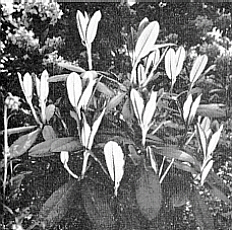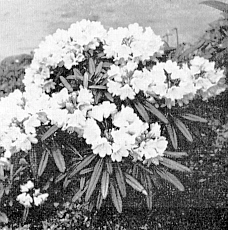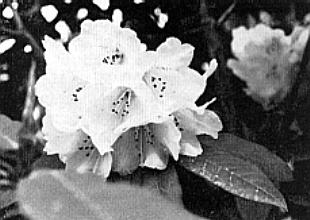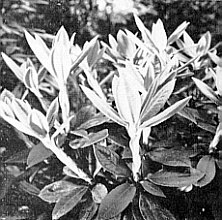QBARS - v24n4 Indumented Rhododendrons on Long Island
Indumented Rhododendrons on Long Island
Walter Maynard, Water Mill, N. Y.
Some years ago, my wife and I toured a number of Scottish gardens with the Rhododendron Group of the RHS. In the private gardens the plants were often unlabeled, and lively discussions of identity were frequent. The first thing the experts did when asked to identify a plant was turn a leaf over, because a considerable proportion of the rhododendrons grown in that mild climate are indumented, and the variations in the felting of the underside of the leaves, of the petioles, and of the new growth provide important leads to identity.
Since then, intrigued by the sumptuous quality of the foliage of indumented rhododendrons, I've been collecting them, and have come to like them more and more, for their year around interest. Many varieties that have been tried have been found too tender here, but the plan's described below seem well worth an experiment in areas where the winter minimum temperature isn't below 0°.
R. smirnowii (Ponticum Series) should probably be first choice for the indumentum collector. My best plants of this species have come from Oliver Nurseries, Fairfield, Conn., who offer an excellent form. The shrub is a semi-dwarf; the leaves are 6½" x 3¾" with a pale cream velvety indumentum beneath. The upper surface of the leaf is dark olive green with considerable powdering near the petiole, which is lightly indumented. The first year stems and buds are also covered with thin whitish indumentum. The plant holds it leaves for two years, so it has a dense, well-furnished appearance. The flowers on my plants, which appear in mid-May, are a lively pink, the truss composed of 2½" flowers with a darker pink stripe on the back of each petal. I feel that this hardy handsome plant should be in every collection.
So much has been written about yakushimanum ( Ponticum Series) that only a few comments on this attractive dwarf seem necessary. The pale orange indumentum is interesting, but hard to see, because the leaves are not only arched lengthwise, but very curled in cross-section. The petioles and buds are felted in pale cream and the current year's growth is felted in tan. The flowers are perhaps the most charming of all rhododendrons, with unfolding flowers first pink, then white. Although it is an extremely slow grower, the plant in all its forms, including Sir. Leach's 'Mist Maiden', fully deserves its high reputation.
On the Scottish trip referred to above, a vivid memory is of the garden at Crarae, where, on a hillside high above Loch Fyne, 7' plants of fulvum displayed, in a stiff breeze, the velvety chamois-pink of the leaf undersides. R. fulvum is slow to bloom and my plants have not yet set buds, but the plants seen in the British Isles have trusses of 18 or so 1½" flowers, white, flushed pink.

|

|
|
Fig. 63.
R. fulvum
, showing the
young foliage. Photo by Cecil Smith |
Fig. 64.
R. metternichii
, taken
in the garden of Cecil Smith. Photo by Cecil Smith |
An indumented dwarf plant with excellent flowers is metternichii (Ponticum Series). Here the indumentum is somewhat plastered down rather than velvety so that the underside of the leaf has a certain sheen of a fawn-gold color. Wada's form of metternichii probably has the best foliage, the oblanceolate leaves being up to 6½" long, but the best flowers appear to be on the Alpenglow form, which took "best species in show" at the early show of the N. Y. Chapter of the ARS in 1969. A completely hardy plant of a different type is 'Sir Charles Lemon' ( arboreum x) which eventually will grow into a large shrub, 10' or more. The leaves, up to 6" long, are a dark velvety green, lightly impressed above with veins. The undersides are covered with a rusty-orange indumentum, very striking when grown on a bank so that the foliage can be viewed from underneath. 'Sir Charles' should be considered as only a handsome foliage plant, because the flowers are said not to appear for 20 or more years, and when they do, form a rather commonplace medium-sized white truss.
R. makinoi is last to be discussed. It is a highly distinctive plant for its rounded semi-dwarf habit of growth and its lance-shaped leaves 7" or more long, bright green with slightly impressed veins above, arched in cross section, making them appear even narrower than their actual width of 1½". Below, the leaves have a thick pink-tan indumentum and the petioles, buds and new growths are also tan-felted. The flowers are large and handsome, medium pink, 2" in diameter in a truss of 8 or so flowers. This plant, of Japanese origin and appearance, likes semi shade. It seems worthy of much wider usage for the foliage interest it can add to a shrub border.
Other indumented species worth trying include bureavii , crinigerum , degronianum (of which there is a big handsome specimen at Planting Fields), fictolacteum , metternianum and ungernii . The Knaphill form of campanulatum has a good orange brown indumentum under the smallish olive green leaves. A problem for the collector is to get species which are true to name. Indumentation is a characteristic which seems only infrequently to be transmitted to hybrids, where one parent lacks it; therefore cutting grown, grafted or layered plants from the best sources are preferable to plants grown from seed, which usually show some degree of hybridity and lack indumentum.

|

|
|
Fig. 65. R. 'Sir Chas. Lemon' it does have
nice flowers as well as foliage. Photo and comment by Dr. Phetteplace |
Fig. 66.
R. bureavii
, showing
young foliage. Photo by Cecil Smith |
There are a few hybrids, other than 'Sir Charles Lemon' which I have grown and appear to be worthwhile for their indumentum. The late Halfdan Lem propagated a bureavii x smirnowii hybrid which has a rich orange-brown indumentum. 'Fabia' x bureavii is somewhat similar in appearance. 'Europa' ( kyawii x ungernii ), a Rothschild cross, has a good whitish-grey felting on the leaf undersides. R. yakushimanum x zeylanicum has; somewhat surprisingly, proven to be hardy and has a chamois-orange felting beneath the leaves. Experimenters might well try smirnowii x fictolacteum and smirnowii x fulvum , both parents being indumented, the offspring would seem to have a good chance of inheriting this desirable characteristic.
In conclusion, it can safely be said that every rhododendron fancier can add greatly to the interest of his collection by including as many as possible of the indumented varieties, even if he doesn't live in the milder rhododendron districts.
